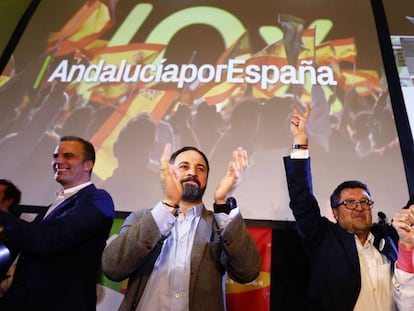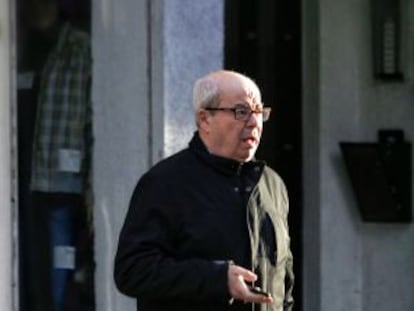Killing the memory of Spanish activist Yolanda González
Vandals have defaced the plaque paying tribute to the young student murdered by far-right militants in 1980

On November 18, the district council of Latina in Madrid inaugurated a plaque in memory of Yolanda González, a 19-year-old student activist who was kidnapped and shot in 1980 by far-right militants from the New Force (FN) party.
A week later, a swastika had been painted over the tribute, as though someone wanted to kill her memory. Then, last weekend, a resident found the plaque in the trash, prompting a group of locals to put up a temporary laminated plaque in its place.
The tribute on the plaque read: “Yolanda González Martín. She was a student leader, worker and Socialist Worker Party militant. She fought for democracy, justice and social and workers’ rights. In February 1980, she was abducted from her house in Aluche and shot by a fascist group. She was 19 years old. These gardens are dedicated to her memory which lives on.”
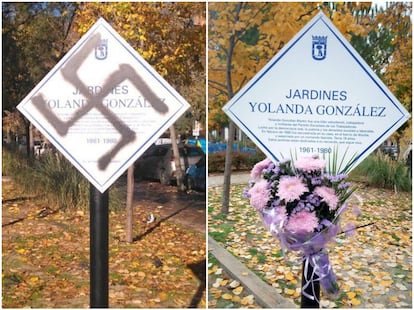
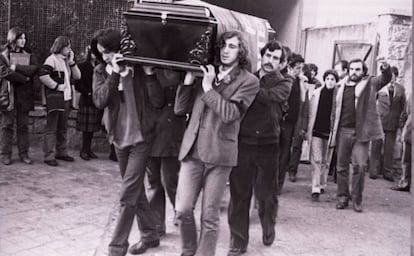
“It’s not just painful, it makes you angry,” says Mar Noguerol who shared an apartment with González and her boyfriend until González was kidnapped by Emilio Hellín and his henchmen and taken to a wasteland where she was shot by the extremist. “This totally reflects what right-wing totalitarianism is about, with its violent response to everyone who doesn’t think as they do. She was a woman with a very clear vision. She was very independent, determined and idealistic like all of us from that generation who went on mass protests and were militant about ending the dictatorship and making sure the Transition [to democracy] was more than a half-baked effort. She started getting interested in politics at 16. She came to Madrid for love and to start a new life with her partner in my apartment in Empalme, which is where she was abducted. It was years before I could go back there.”

The 60-square-meter apartment González moved to with her boyfriend Alejandro Arizcun was on Tembleque Street in Aluche. Once in Madrid, she took a job as a cleaner to fund her living expenses while studying electronics. But much of her time was spent in pro-democracy demonstrations.
On February 1, 1980, González was alone in the apartment when the bell rang. She opened the door and found herself facing members of Group 41, a criminal gang linked to NF. The men forced their way in and searched for evidence that González had ties to Basque terror group ETA. She did not and they found nothing. But they were undeterred. They hauled her downstairs and forced her into a car. And they interrogated her all the way to the wasteland by the highway linking Alcorcón and San Martín de Valdeiglesias. When they reached their destination, they shot her three times. Shortly after, EL PAÍS published the story on the front page of the newspaper with the title “New Force militants murder Yolanda González.”
Almost 40 years have passed since that day. The crime, which had all the elements of a thriller including the murderer’s escape to Paraguay, gripped the country. But the plaque that paid tribute to González lasted less than a month.
New Plaque
“It’s inexplicable,” says Carlos Fonseca, who wrote Don’t Forget Me. Yolanda González, the Most Brutal Crime of the Transition, based on the testimonies of González’s colleagues and friends, photos and documents. “Yolanda didn’t run any political party nor was she a particularly significant figure. It was a cruel murder. I can’t get my head around what kind of hatred could still exist towards a girl who was brutally murdered 38 years ago and whose ‘crime’ was to be a left-wing youngster living in that era.”
Meanwhile, Carlos Sánchez Mato, president of the district council, says that though the plaque itself cannot be salvaged, the fact it was rescued from the trash indicates there are still plenty of decent people in the city. “We received threats when it was inaugurated,” he says. “These people are cowards who are capable of little more than miserable acts such as tearing down a plaque in memory of a student murdered by fascists. It is despicable. And obviously we’re going to put it back up. A thousand times if need be.”
Temporary plaque also destroyed
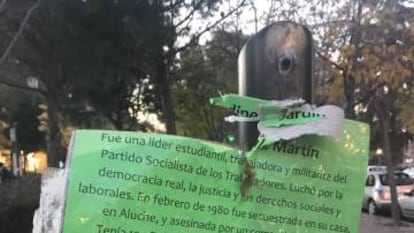
Just days after it was put up, the temporary laminated plaque in tribute to the activist has been destroyed by vandals. In response, 20 locals have put up posters in her memory across the neighborhood. “They even want to deny us from remembering our victims,” says Noguerol.
“This is not a crazy person, a guy who comes the park, takes down the plaque and rips it apart. It's a fascist group from the neighborhood,” says Josefa.
English version by Heather Galloway.
Tu suscripción se está usando en otro dispositivo
¿Quieres añadir otro usuario a tu suscripción?
Si continúas leyendo en este dispositivo, no se podrá leer en el otro.
FlechaTu suscripción se está usando en otro dispositivo y solo puedes acceder a EL PAÍS desde un dispositivo a la vez.
Si quieres compartir tu cuenta, cambia tu suscripción a la modalidad Premium, así podrás añadir otro usuario. Cada uno accederá con su propia cuenta de email, lo que os permitirá personalizar vuestra experiencia en EL PAÍS.
¿Tienes una suscripción de empresa? Accede aquí para contratar más cuentas.
En el caso de no saber quién está usando tu cuenta, te recomendamos cambiar tu contraseña aquí.
Si decides continuar compartiendo tu cuenta, este mensaje se mostrará en tu dispositivo y en el de la otra persona que está usando tu cuenta de forma indefinida, afectando a tu experiencia de lectura. Puedes consultar aquí los términos y condiciones de la suscripción digital.
More information
Archived In
Últimas noticias
Maduro pleads not guilty before the federal court in New York: ‘I am still the president of Venezuela’
A new test can detect Alzheimer’s from a finger prick
UN team enters Sudanese city of El Fasher after paramilitary massacre: ‘It’s like a ghost town’
A recipe for resistance: Indigenous peoples politicize their struggles from the kitchen
Most viewed
- Gilles Lipovetsky: ‘If you want to live better and fall in love, take Prozac, don’t look to philosophy’
- Alain Aspect, Nobel laureate in physics: ‘Einstein was so smart that he would have had to recognize quantum entanglement’
- Alvin Hellerstein, a 92-year-old judge appointed by Bill Clinton, to preside over Maduro’s trial in New York
- Maduro’s downfall puts China’s relationship with Venezuela to the test
- Why oil has been at the center of Venezuela-US conflicts for decades

